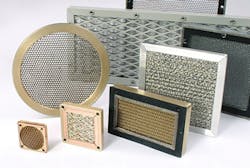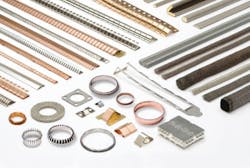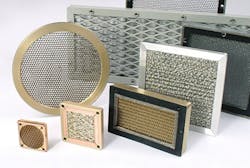Electromagnetic (EM) and radio-frequency (RF) energy sources surround us in the form of various electronic devices, all of which are capable of causing interference for one another. Fortunately, proper application of EM and RF shielding materials can minimize opportunities for interference. The large number of sources that can generate EM interference (EMI) and RF interference (RFI) often makes it necessary to install multiple levels of EM shielding into a design, from the circuit and package levels through the enclosure level.
Related Articles • Filtering EMI And RFI Noise • Use SSC Oscillators To Banish EMI • Probing Problems Based On EMIProper use of shielding materials helps a large number of high-frequency circuits co-exist when fairly tightly spaced in the same environment. The right amount of shielding material can prevent leakage of unwanted EM and RF radiation and for most designs the trick is knowing which type of shielding material to use and just how much shielding is enough.
Shielding materials come in many forms, including meshes, foils, cloths, tapes, and heat shrink tubing (Fig. 1). Many of these materials can provide very high suppression of EM and RF radiation levels. Of course, simply adding shielding materials to an electronic design can be expensive; the time-honored tradeoff is to use enough shielding materials to bring EM and RF radiation levels within desired boundaries, but without adding excessive cost to the design.
1. EMI shielding gaskets and other materials can be added at different stages of a design to limit EMI/RFI radiation. (Photo courtesy of Tech-Etch.)
How well an EM/RF shield performs is usually denoted by a parameter known as shielding effectiveness (SE), which measures the amount of power or field strength around an electronic device before and after shielding has been applied:
SE (in dB) = 10log(Pi/Pe)
or
SE (in dB) = 10log(Fi/Fe)
where:
Pi = the incident power density,
Pe = the exit power density,
Fi = the incident field strength, before shielding, and
Fe = the exit field strength, after shielding.
A shield can dissipate or absorb energy, and also reflect or redirect energy—the net result is that the shield has reduced the amount of energy around an electronic device. Various means are used to measure the SE of different materials, with probably the best known approach being the military standard MIL-STD-285. This standard is based on a high-level signal source and two antennas (loop, rod, or dipole antennas): one to transmit and one to receive at the frequencies of interest. More severe shielding measurement standards, such as TEMPEST requirements, exist, but these are applied as needed for different applications, such as for US National Security Agency (NSA) applications.
Different techniques developed over the years for measuring SE include the open-field or free-space method (which essentially detects radiation escaping from a finished product), the shielded box method, the shielded room method, and the coaxial transmission-line method. The shielded-box method is often used to compare the performance levels of different shielding materials. It employs a metal box with tight seam and sample port in one wall fitted with a receiving antenna. A transmitting antenna and signal source are placed outside of the box, and measurements are made with and without the material sample over the test port.
Unfortunately, this approach does not correlate well from one facility to the next and is limited to about 500 MHz in usable frequency range. The limitations of this method are overcome somewhat by using a larger shielded room, in which the dimensions of everything in the test setup (including the test material sample) are larger.
The coaxial transmission-line method, with measurements performed on small donut-shaped samples, has become the preferred SE test method. Measurements can be made at specific frequencies using a modulated signal generator, crystal detector, and tuned amplifier, or in swept mode with a tracking generator and a spectrum analyzer. A variable attenuator is set to maximum and a measurement made without the sample holder in place. Then the sample is added and the attenuation reduced until the reading is the same, which is the SE of the sample.
Surveying Materials
Shielding materials such as gaskets often provide an environmental seal in addition to suppressing radio interference. These are commonly rubberized materials, such as silicone rubber or fluorosilicone rubber with embedded silver-plated silver or copper particles to enhance conductivity. They are formed into sheets, such as 12 x 12 in., which can then be die-cut into the shapes and forms needed to seal an enclosure. In addition, nickel and graphite are more commonly used in EM/RF shields for their dimensional stability. For example, nickel-graphite-filled silicone rubber is a compressible material that provides a high level of EM/RF shielding; it also forms a reliable environmental seal due to the compression. Shielding solutions continue to evolve over time, with newer base materials (such as graphene) attracting a great deal of attention for its light weight and capability of achieving high SE levels.
Depending upon the requirements, some applications may require EMI/RFI filters (Fig. 2) to screen interference, but these are usually more severe cases. Such filters add weight and cost; typically, lower-weight, lower-cost shielding solutions are preferable, such as simple meshes or shielding gaskets. A mesh can be effective at blocking EMI/RFI as long as the size of the mesh is smaller than the wavelength of the frequencies of interest. If it is larger than the wavelengths of the signals of interest, those signals will get through, although they may be somewhat attenuated by the partial action of the mesh.
2. In some extreme cases, EMI/RFI filters may be needed to perform frequency-selective attenuation of unwanted signal energy in an electronic design. (Photo courtesy of Tech-Etch.)
How much EMI/RFI shielding can be achieved by a gasket or other shielding material at a given frequency? The amount of shielding is a function of the material and the frequency of concern, as well as the form in which the shielding material is applied—such as in the form of a shielding window or gasket. Most suppliers of shielding products, like Chomerics, will work closely with customers to even die-cut shielding gaskets as needed for different product enclosures. As an example, Chomerics offers a 200-page-plus online catalog devoted to shielding products, with materials that include shielding vents and windows, shielding adhesives, wire mesh gaskets, and cable shielding.
Related Articles • Filtering EMI And RFI Noise • Use SSC Oscillators To Banish EMI • Probing Problems Based On EMIThe firm also offers design services and supports its analysis through computer-aided-engineering (CAE) tools, such as finite-element-analysis (FEA) software. While shielding solutions tend to vary by material and by frequency, the firm is best known for its standard CHO-SEAL 1310 conductive elastomer material. This provides better than 60 dB SE from 200 MHz to 10 GHz, with higher values of SE available as needed. Similarly, Leader Tech offers a large catalog of conductive elastomer materials for free download from their website.
Due to its expanding use of RF/microwave technologies, the modern automobile is becoming one of the more challenging electronic environments. With its many different systems—from high-frequency (HF) through millimeter-wave frequencies—newer automobiles are resident to a large number of RF/microwave signals within a tightly confined space. That space is also subject to shock, vibration, and wide temperature extremes.
Problems from EMI in a newer automobile can stem from collision-avoidance radar systems, from built-in Global Positioning System (GPS)/navigation systems, fuel control systems, adaptive cruise control systems, and electronic ignition systems, just to name a few. Shielding materials are now essential components in most automotive electronic systems, for proper compliance and operation of those systems along with their coexistence with other automotive electronic systems and other external electronic systems, such as wireless garage-door openers.
Editor’s Note: The companies mentioned in this report are only a few examples of many high-quality suppliers of shielding materials and services. Any search for such suppliers can be made easier with the aid of the Microwaves & RF Product Data Directory.
About the Author
Jack Browne
Technical Contributor
Jack Browne, Technical Contributor, has worked in technical publishing for over 30 years. He managed the content and production of three technical journals while at the American Institute of Physics, including Medical Physics and the Journal of Vacuum Science & Technology. He has been a Publisher and Editor for Penton Media, started the firm’s Wireless Symposium & Exhibition trade show in 1993, and currently serves as Technical Contributor for that company's Microwaves & RF magazine. Browne, who holds a BS in Mathematics from City College of New York and BA degrees in English and Philosophy from Fordham University, is a member of the IEEE.


